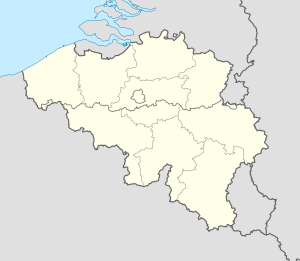Citadel of Liège
| Citadel of Liège | |
|---|---|
| Part of Fortifications of Liège | |
| Liège, Belgium | |

Surviving walls of the citadel
|
|
| Coordinates | 50°39′07″N 5°34′41″E / 50.652°N 5.578°ECoordinates: 50°39′07″N 5°34′41″E / 50.652°N 5.578°E |
| Type | Fort |
| Site information | |
| Owner | Hôpital CHR Citadelle |
| Controlled by | Belgium |
| Open to the public |
Yes |
| Condition | Parkland, hospital site |
| Site history | |
| Built | 1255 |
| Materials | Masonry |
| Battles/wars | Battle of Liège, Battle of Belgium |
The Citadel of Liège was the central fortification of the strategic Belgian city of Liège until the end of the 19th century. It is located in the Sainte-Walburge neighborhood, 111 metres (364 ft) above the Meuse valley. The first citadel was built on the heights overlooking the city in 1255. It was rebuilt in a pentagonal shape by Prince-Bishop Maximilian Henry of Bavaria in 1650. This fortress was destroyed by France shortly afterwards, then rebuilt in 1684. During the Napoleonic Wars it was given five bastions in the style of Vauban. By the late 19th century the citadel had become obsolete, replaced by the twelve forts of the Fortified Position of Liège. It continued in use as a barracks and as a command post. In the 1970s the citadel was largely destroyed by the construction of a hospital on the site. The southern walls remain. An area on the north side is a memorial to Belgians executed in the citadel by German occupiers in World Wars I and II, while 20th-century bunkers remain on the south side.
Around the year 1000, during the reign of Notker, Prince-Bishop of Liège, the city built its first walls in sandstone. The enclosure was shaped like an elongated rectangle of about 25 hectares (62 acres), surrounded with a ditch and lined with towers and gates. A gate tower was built at the foot of Pierruse. The first bridge at the site of the Pont des Arches was built around 1033. In the early 12th century Holy Roman Emperor Henri IV proposed a larger enclosure, but failed to raise the necessary funds. A new wall was started in 1204 from the Porte Sainte-Walburge to Paienporte, then down to the river, and another wall was under construction between the Hocheporte and Sainte-Walburge. In May 1212 the still uncompleted walls were scaled by the troops of Henry I, Duke of Brabant, who sacked the city. Encouraged by this setback, the townsmen completed the walls in 1215.
In 1255 Prince-Bishop Henri de Gueldre built the Porte Sainte Walburga, furnished with towers, a well, a drawbridge and a prison, which was in effect the first citadel on the site. In 1468 the troops of Charles the Bold destroyed the city despite an attack by the 600 Franchimontois.
...
Wikipedia

